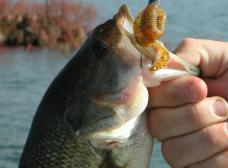Beat the bank-fishing blues
Stalk your prey!
Wear neutral coloured clothing that will blend in with the surrounding environment. Camo works well. Avoid bright colours!
The shoreline is the number one bass holding area so, where possible, try to present your first cast before you have reached the edge of the water.
Try to stand next to a tree or bush (or any other large object) when casting because this helps to disguise your shape.
To avoid spooking bass that might be feeding or sunning in the shallows, start with your quietest lures first (worms/plastics) and then progress to the noisier lures (topwaters/spinnerbait).
Read the Water
Use your eyes!
Find areas along the bank with something different close by to attract bass -
fallen timber, weeds, riprap or a small river.
Observe!
What does the bank look like? Do you see rocky areas along the bank? Do they extend into the water? Is the surrounding terrain hilly or filled with small koppies? Chances are there could be a hump or two in the dam. Look at weed growth in the water; a patch of weeds growing in deeper water = that spot is shallow enough for weeds to grow = hump. Humps are prime bass-holding spots.
Lures - Keep it simple!
Texas-rigged worm/lizard – Use around cover such as brush, wood and grass beds.
Spinnerbait – Excellent for fishing murky water in all temperatures.
Soft Jerkbait – This category includes lures such as flukes, flounders, flapping shads and a very old favourite, sluggo’s. Twitch these in clear and lightly stained water during spring and autumn. These lures can also be used in the place of conventional texas/Carolina/mojo-rigged plastics during the hot summer months and colder winter months.
Topwater – Best during the summer. A hard jerkbait, cylindrical bait (zara spook) and popping baits are recommended in clear water. Try a prop-bait or buzz-bait in stained murky water.
Jig-and-pig – Especially good for large bass around woody cover. Best fished in spring.
Weedless Rats, Frogs, etc. – These are good to use when fishing weedy areas with abundant surface cover, such as lily pad beds, during the summer.
Lipless Crankbait – Good to use in stained or muddy water from spring through to autumn.
Floating Worms – This range includes Trick worms and is a great choice to use during the spring. Best used in clear to lightly stained water.
Gear - Travel light!
Rod & Reel – A 6- to 6 ½ -foot medium spinning or medium heavy baitcasting rig should be able to handle most bank fishing presentations.
Line – 15- to 20-pound line - submerged brush and when you know there are large bass that live in the dam.
6- to 10-pound line - ultra-clear water with virtually no cover.
10- to 14-pound line - a new dam with no prior knowledge.
Tacklebox – You need to find a small compact box that has enough space to pack a variety of different lures for any kind of application. Always remember that you will be carrying this around with you as you move around the bank so try to find something practical.
Insect Repellent – is always a necessity when traversing the banks. Water attracts mosquitoes and thick grass usually holds ticks. Apply liberally before you start fishing but remember to wash your hands before you start handling your lures.
Backpack – It makes sense to invest in a small comfortable backpack to carry all of the above plus an extra bottle of water and a lunch pack.














0 Comments